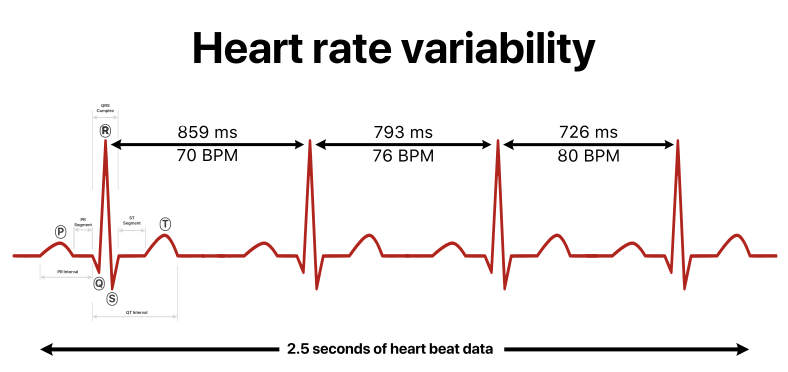What is Heart Rate Variability?
Heart rate variability is a measure of the beat-to-beat changes in heart rate. The diagram below shows three heartbeats recorded on an electrocardiogram (ECG). Note that variation in the time interval between consecutive heartbeats, giving a different heart rate (in beats per minute) for each interbeat interval.

The normal variability in heart rate is due to the synergistic action of the two branches of the autonomic nervous system —which regulates most of the body’s internal functions.
The sympathetic nerves (commonly known as our fight or flight) work to accelerate heart rate, while the parasympathetic (vagus or our rest and digest) nerves slow it down. The sympathetic and parasympathetic branches of the nervous system are continually interacting to maintain cardiovascular activity in its optimal range and to permit appropriate reactions to changing external and internal conditions.
The analysis of HRV therefore serves as a dynamic window into the function and balance of the autonomic nervous system, our overall health and wellbeing.
So What? Why is this Important?
Well, imagine you’re running for the bus, Your muscles engage, your breath becomes rapid and you run for your life and you make it on the bus. But do you find yourself huffing and puffing and having difficultly to regulate?
For those with high HRV, they are quickly able to down regulate and enjoy the rest of their bus ride at ease. While those with low HRV, will find it hard to regulate. Their nervous system gets triggered so even if their body is not experiencing the stress, it remains in a state of fight or flight.
Scientists and physicians consider HRV to be an important indicator of health, fitness and resilience. The ability to regulate and improve our HRV says something about our mind body coherence and our body’s natural regenerative process.
For those of you who have wearables, you’ll notice your recovery or readiness score. You’ll see that on days that you have a higher HRV score, you readiness is scored better too. This is crucial in your physical, physiological and emotional resilience.

Increase your HRV, Improve your Health
HRV is also a marker of biological aging. Our heart rate variability is greatest when we are young, and as we age the range of variation in our resting heart rate becomes smaller. Although the age-related decline in HRV is a natural process, having abnormally low HRV for one’s age group is associated with increased risk of future health problems and premature mortality.
Low HRV is also observed in individuals with a wide range of diseases and disorders. By reducing stress-induced wear and tear on the nervous system and facilitating the body’s natural regenerative processes, regular practice of coherence-building techniques, resourcing practices from mindfulness, somatic work we can help restore low HRV to healthy values.
During your nervous system consultation at Soma Haus, we will observe your heart’s changing rhythms in real time. Using your pulse data to provide a picture of your HRV. We can then work out a treatment plan to help you improve your HRV, mind body coherence, resilience and restore the body’s natural regenerative process.